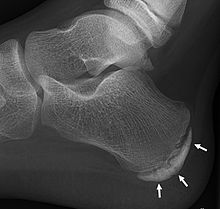| Calcaneal apophysitis (Sever's disease) | |
|---|---|
| Other names | Calcaneus apophysitis, Severs |
 | |
| X-ray of the foot of an 11-year-old child, showing sclerosis and fragmentation of the calcaneal apophysis. This is a sign of low sensitivity and specificity of Sever's disease, because those with Sever's disease may not have it, and this appearance is also present in feet without pain.[1] | |
| Specialty | Rheumatology |
| Symptoms | in the heel |
Preview warning: Page using Template:Infobox medical condition with unknown parameter "1 = duration
"
Sever's disease, also known as calcaneus apophysitis, is an inflammation at the back of the heel (or calcaneus) growth plate in growing children. The condition is thought to be caused by repetitive stress at the heel. This condition is benign and common and usually resolves when the growth plate has closed or during periods of less activity. It occurs in both males and females. There are a number of locations in the body that may get apophysitis pain. Another common location is at the front of the knee which is known as apophysitis of the tibial tuberosity or Osgood–Schlatter disease.
- ^ Mark A Noffsinger (2016-09-07). "Calcaneal Apophysitis (Sever Disease) Workup". Medscape. Retrieved 2017-01-19.